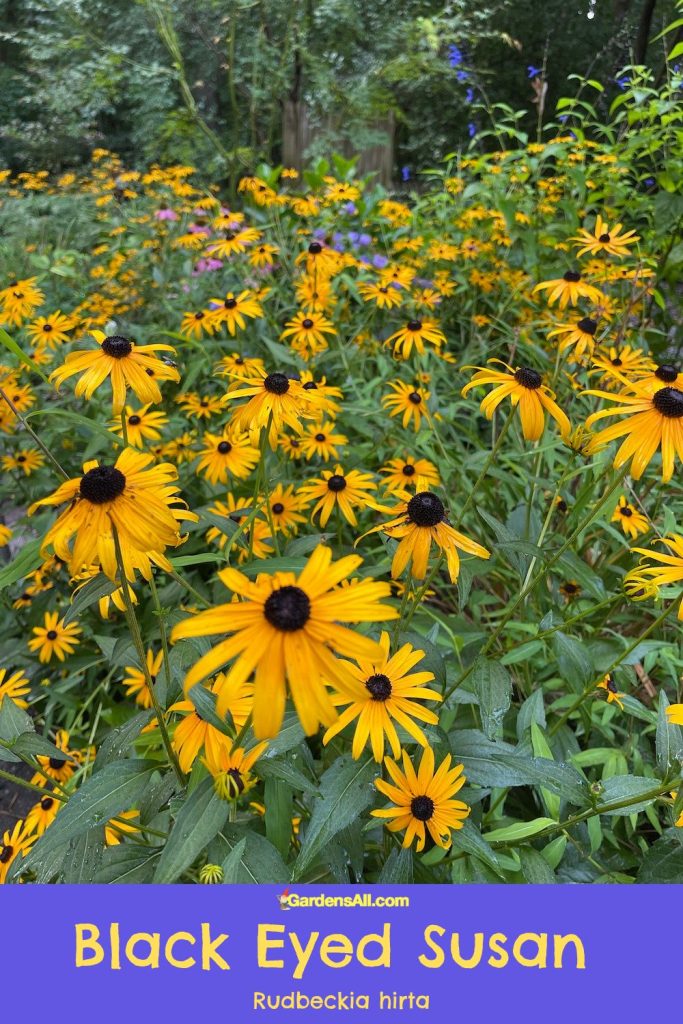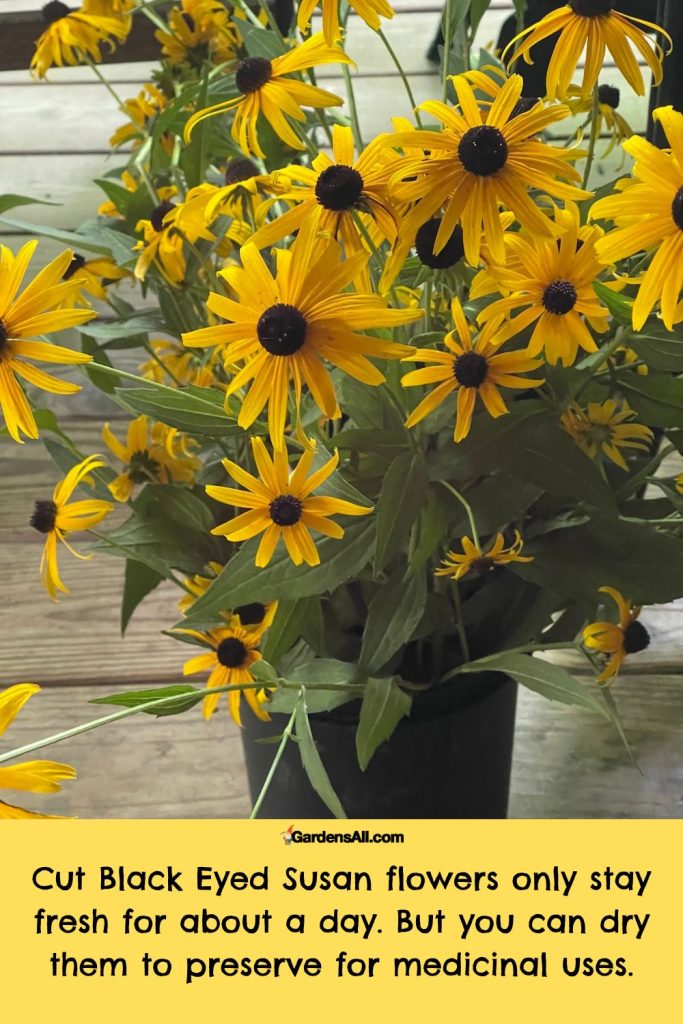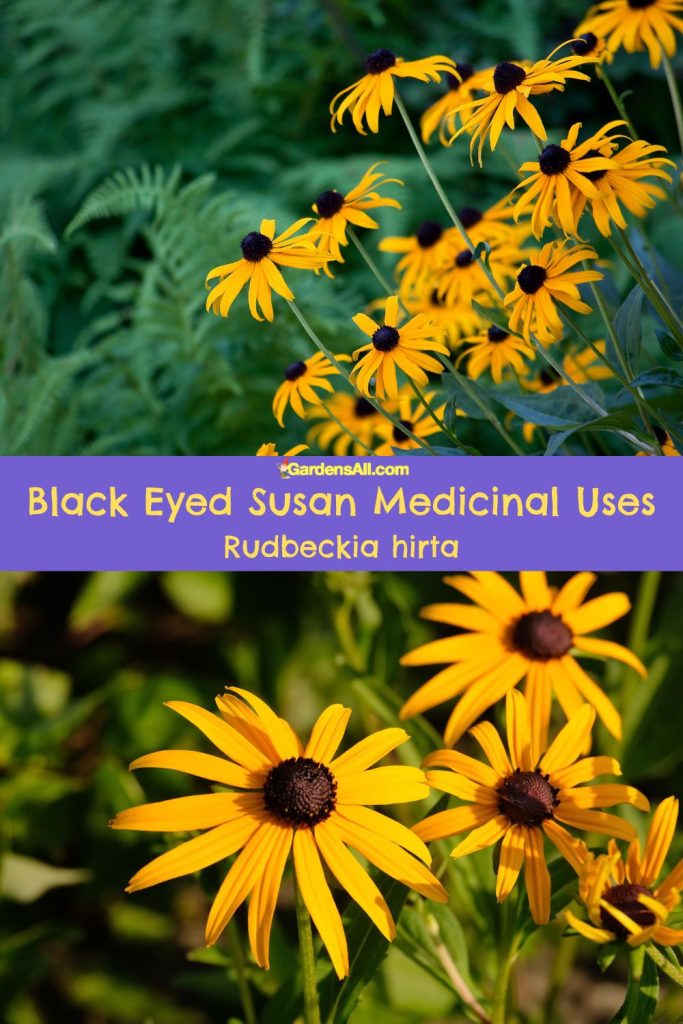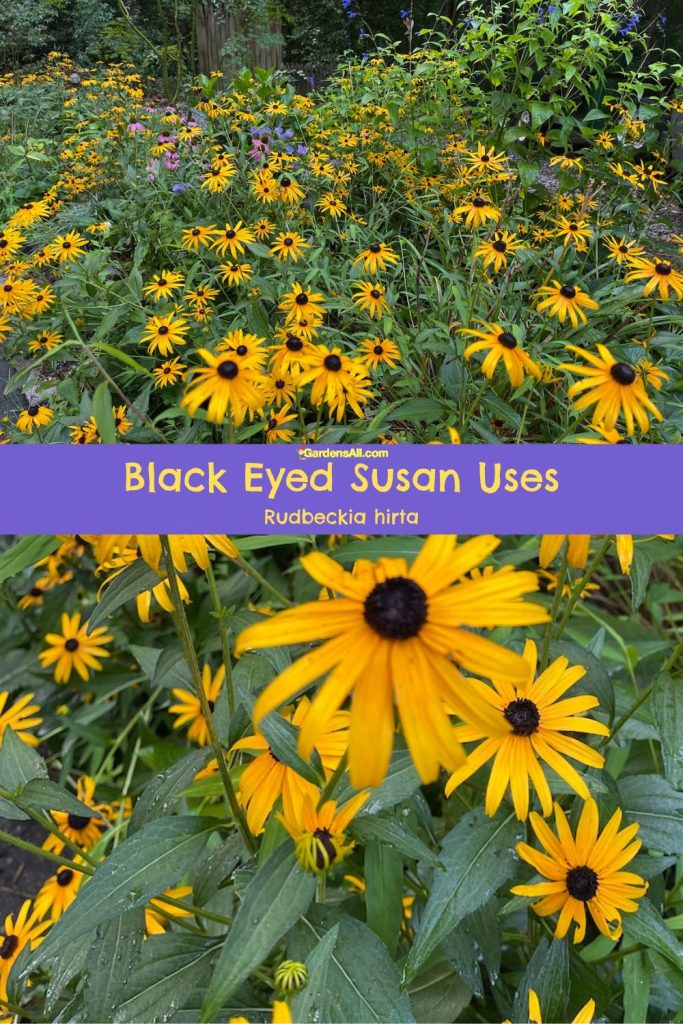More than just a pretty face with the familiar yellow-petaled flowers and a dark center; Black Eyed Susan medicinal benefits are also worth a second glance.
Known scientifically as Rudbeckia hirta, this popular flower has a history of medicinal use by Native American tribes. The plant, alongside its close relatives in the Rudbeckia genus, has been used traditionally in herbal remedies for a variety of ailments.
This article delves into the medicinal uses of Black Eyed Susan (Rudbeckia hirta). We’ll highlight the parts of the plant that are utilized and their potential benefits, many of which are shared by popular plants in its asteraceae family, such as the widely known medicinal echinacea plants.
If you have allergies to any plants in the asteraceae family, this plant may not be an option for you medicinally. However, you may still be able to enjoy it in your landscape, unless your skin reacts to contact. In that case, avoid it or wear gloves and long sleeves when tending it.

Black Eyed Susan (Rudbeckia hirta) Taxonomic Classification
If you enjoy knowing the plant family associations, here’s the Black Eyed Susan taxonomy.
- Kingdom: Plantae
- Subkingdom: Viridiplantae
- Infrakingdom: Streptophyta
- Superdivision: Embryophyta
- Division (or Phylum): Tracheophyta
- Subdivision (or Subphylum): Spermatophytina
- Class: Magnoliopsida
- Superorder: Asteranae
- Order: Asterales
- Family: Asteraceae (or Compositae)
- Genus:Rudbeckia
- Species: Rudbeckia hirta
- Genus:Rudbeckia
- Family: Asteraceae (or Compositae)
- Order: Asterales
- Superorder: Asteranae
- Class: Magnoliopsida
- Subdivision (or Subphylum): Spermatophytina
- Division (or Phylum): Tracheophyta
- Superdivision: Embryophyta
Please note that taxonomies can be subject to updates and modifications as scientific understanding evolves. Always refer to the latest taxonomic databases or literature for the most up-to-date information.

Rudbeckia Black Eyed Susan Medicinal Uses
We tend to prefer seeing these beautiful flowers in our yard and garden landscape. However, we also love knowing about the many incredible benefits of the plants all around us, for when and if we may need them for more than their beauty.
So when a section of our tall Rudbeckia plants were fallen over from a heavy rain, we put them to good use. The first day was as a vase of beautiful flowers. Then the next we set about drying them, for the cut flowers only stay fresh for about a day.

What Parts of Black Eyed Susan are Used and How?
The Black Eyed Susan, with its iconic yellow petals and dark center, has been favored not just for its beauty but also for its medicinal properties. Here’s a detailed look at which parts of the plant have been traditionally employed for their healing potential, and how they’ve been used.
Rudbeckia hirta Roots Uses
- Preparation: The roots of the Black Eyed Susan and other Rudbeckia species are typically harvested in the fall when the plant’s medicinal compounds are believed to be most potent. After harvesting, they’re washed, dried, and can be stored for later use.
- Usage:
- Tea: Dried roots are often boiled in water to produce a medicinal tea which is consumed for various ailments such as colds or digestive issues.
- Poultice: For external applications, the roots can be ground into a paste and applied as a poultice on wounds, boils, or insect bites. This method leverages the plant’s potential antimicrobial and anti-inflammatory properties.
- Tinctures: The roots can also be soaked in alcohol to produce tinctures, which can be taken internally for various therapeutic effects.
You can find black eyed susan tincture on Amazon.
Leaves of Black Eyed Susan
- Preparation: The leaves can be harvested during the plant’s flowering stage. After collection, they can be dried in a shaded area, away from direct sunlight, and stored. (See drying herbs).
- Usage:
- Tea: Like the roots, dried leaves can be steeped in hot water to make tea, which might be consumed for sore throats or other ailments.
- Salves: Occasionally, the leaves might be incorporated into salves or ointments, which can be applied to the skin for potential anti-inflammatory effects.
Black Eyed Susan Flowers
- Preparation: Flowers are usually harvested during full bloom. After picking, they can be dried and stored for later use.
- Usage:
- Infusion: Flowers can be steeped in hot water to create infusions. While less commonly used than root or leaf preparations, teas might be consumed for their potential calming and immune-boosting properties.
- Decoration in Herbal Mixtures: Sometimes, the dried flowers are added to herbal mixtures for their aesthetic appeal. Though they’re primarily ornamental in this context, they can also impart some of the plant’s medicinal properties.
See When and How to Harvest Echinacea for more info on drying Black Eyed Susans.

Rudbeckia Medicinal Uses and Benefits
Most of the Black Eyed Susan medicinal uses here are ethnobotanical, meaning used by traditional cultures throughout the centuries. However, wherever we found scientific research revealing some of the potent medicinal benefits of Rudbeckia, we’ve included that as a footnote.
- Anti-inflammatory: [1]https://www.researchgate.net/publication/261217365_Evidence-based_medicinal_value_of_Rudbeckia_hirta_L_flowers
- Antioxidant: [2]https://www.researchgate.net/publication/261217365_Evidence-based_medicinal_value_of_Rudbeckia_hirta_L_flowers
- Cold and Flu: Rudbeckia roots have been used as an immune booster in some traditional medicines. It’s believed to help alleviate symptoms of cold and flu, potentially due to its immune-boosting effects.[3]https://www.researchgate.net/publication/261217365_Evidence-based_medicinal_value_of_Rudbeckia_hirta_L_flowers
- Digestive Aid: The roots have also been traditionally consumed as a tea to address minor digestive issues, such as indigestion or stomach upsets.
- Diuretic Properties: The roots of Black Eyed Susan have been used as a diuretic, which can help increase the amount of urine produced, thereby assisting in the removal of waste from the body.
- Immunity: Ranked high in beneficial immunity boosting compounds when compared to echinacea.[4]https://www.researchgate.net/publication/261217365_Evidence-based_medicinal_value_of_Rudbeckia_hirta_L_flowers
- Skin Conditions: Due to its purported anti-inflammatory properties, a poultice made from the plant’s roots has been used to treat various skin conditions, including boils and acne.
- Snakebites and Insect Stings: Some Native American tribes used the plant as a remedy for snakebites and insect stings. The roots were chewed or made into a poultice to apply to the affected area.
- Throat Ailments: A tea made from the leaves or roots of the Black Eyed Susan plant has been used as a remedy for sore throats and tonsillitis.
- Wound Healing: The root, when made into a poultice, has been applied to wounds to promote healing. This practice stemmed from the belief that the plant has antimicrobial and anti-inflammatory properties.
Scientifically Proven Anti-inflammatory Properties Support Overall Healing
Colds, earaches, sores, snakebites, and wounds are all examples of inflammatory conditions for which the R. hirta herb has been used traditionally. Therefore, the multiple bioactivities of the isolated metabolites of R. hirta flowers, were found to act in a synergistic way as anti-inflammatory, thereby scientifically validating the ethnopharmacological use of the black eyed susan herb for the first time.[5]https://www.researchgate.net/publication/261217365_Evidence-based_medicinal_value_of_Rudbeckia_hirta_L_flowers
You may also enjoy discovering more plant wonders in these articles on other relatives of Rudbeckia hirta. See also calendula benefits and uses as well as benefits of echinacea and dandelion.
Be Careful!
It’s important to remember that this information is not prescriptive medical advice. It’s advisable to do your own research as well as consult with your health and wellness professionals when considering the use of herbal remedies.

I’m LeAura Alderson, a garden, herb and plant enthusiast with a passion for discovering the many edible and medicinal benefits of the plants all around us, including the weeds! I’m a writer, editor and media publisher for our family of websites.
While I was certified in fitness and life coaching, I am NOT a health practitioner. However, I’m a lifelong health enthusiast, with a keen interest in healthy, organic foods and making home remedies and the content we share is from our own experience and usage as well as that extracted from scientific research so that you can explore further on your own.
Always seek the advice and guidance of your health practitioners first and foremost.
As a family we’re steadily expanding our gardening, experimentation and knowledge around all things gardening, edible landscaping, fresh organic foods and self sustainability with farming in our future. I also own and manage iCreateDaily.com, a site all about transformation through creation, and the power of positivity, optimism and mindset.
References

